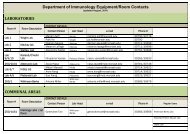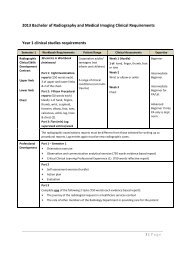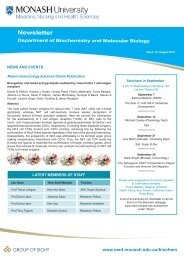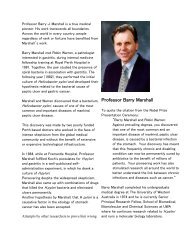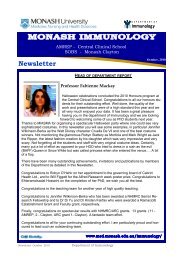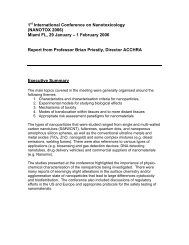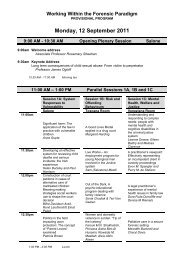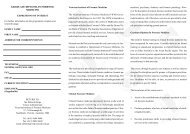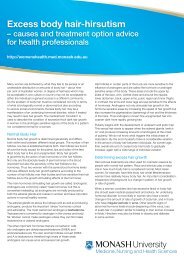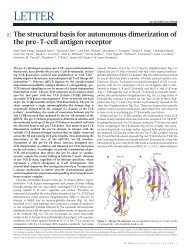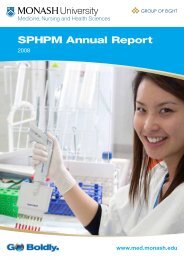Newsletter - Faculty of Medicine, Nursing and Health Sciences ...
Newsletter - Faculty of Medicine, Nursing and Health Sciences ...
Newsletter - Faculty of Medicine, Nursing and Health Sciences ...
Create successful ePaper yourself
Turn your PDF publications into a flip-book with our unique Google optimized e-Paper software.
<strong>Newsletter</strong><br />
Department <strong>of</strong> Biochemistry <strong>and</strong> Molecular Biology<br />
NEWS AND EVENTS<br />
Discovery <strong>of</strong> an Archetypal Protein Transport System<br />
in Bacterial Outer Membranes<br />
Dr Joel Selkrig (Lithgow Lab) <strong>and</strong> colleagues<br />
have discovered a novel protein transport<br />
system, the translocation <strong>and</strong> assembly<br />
module (TAM).<br />
Joel summarised the discovery;<br />
“Autotransporters are bacterial virulence<br />
factors critical for the pathogenesis <strong>of</strong> many<br />
organisms. Exactly how they are assembled<br />
onto the bacterial cell surface remains<br />
contentious. We discovered a novel protein<br />
transport system, the TAM, found in most<br />
sequenced gram-negative bacteria that’s<br />
required for autotransporter biogenesis.<br />
This discovery sheds new light on how autotransporters are assembled <strong>and</strong><br />
may provide a useful target at which to aim antibacterial therapies.”<br />
Joel’s paper was discussed during the first 40 minutes <strong>of</strong> Microbe World’s<br />
broadcast TWiM #31: Screen door on a submarine, link:<br />
http://www.microbeworld.org/index.php?option=com_content&view=articl<br />
e&id=1180:twim-31-screen-door-on-a-submarine&catid=107:this-week-inmicrobiology&Itemid=275<br />
Joel Selkrig, Khedidja Mosbahi, Chaille T. Webb, Matthew J. Belous<strong>of</strong>f, Andrew J. Perry,<br />
Timothy J. Wells , Faye Morris, Denisse L. Leyton, Makrina Totsika, Minh-Duy Phan, Nermin<br />
Celik, Michelle Kelly, Clare Oates, Elizabeth L. Hartl<strong>and</strong>, Roy M. Robins-Browne, Sri Harsha<br />
Ramarathinam, Anthony W. Purcell, Mark A. Schembri, Richard A. Strugnell, Ian R. Henderson,<br />
Daniel Walker <strong>and</strong> Trevor Lithgow. Discovery <strong>of</strong> an archetypal protein transport system in<br />
bacterial outer membranes. Nat Struct Mol Biol. 2012<br />
ABSTRACT: Bacteria have mechanisms to export proteins for diverse purposes,<br />
including colonization <strong>of</strong> hosts <strong>and</strong> pathogenesis. A small number <strong>of</strong> archetypal<br />
bacterial secretion machines have been found in several groups <strong>of</strong> bacteria<br />
<strong>and</strong> mediate a fundamentally distinct secretion process. Perhaps erroneously,<br />
proteins called ‘autotransporters’ have long been thought to be one <strong>of</strong> these<br />
protein secretion systems. Mounting evidence suggests that autotransporters<br />
might be substrates to be secreted, not an autonomous transporter system. We<br />
have discovered a new translocation <strong>and</strong> assembly module (TAM) that promotes<br />
efficient secretion <strong>of</strong> autotransporters in proteobacteria. Functional analysis <strong>of</strong> the<br />
TAM in Citrobacter rodentium, Salmonella enterica <strong>and</strong> Escherichia coli showed<br />
that it consists <strong>of</strong> an Omp85-family protein, TamA, in the outer membrane <strong>and</strong><br />
TamB in the inner membrane <strong>of</strong> diverse bacterial species. The discovery <strong>of</strong> the<br />
TAM provides a new target for the development <strong>of</strong> therapies to inhibit colonization<br />
by bacterial pathogens.<br />
Seminars in May<br />
Issue 22: April 2012<br />
4 pm on Wednesdays in Building 13A,<br />
Lecture Theatre M2<br />
May 2nd<br />
A/Pr<strong>of</strong> Katharina Gaus (University <strong>of</strong> NSW)Insights<br />
into the molecular mechanisms <strong>of</strong> early T cell<br />
signalling<br />
May 9th<br />
Dr Kieran Harvey (PMCI)<br />
The Hippo pathway: organ growth <strong>and</strong> cell-fate<br />
choices<br />
May 16th<br />
Dr. Aleks<strong>and</strong>ra Filipovska (WAIMR)<br />
Regulation <strong>of</strong> the mitochondrial transcriptome<br />
****************<br />
Please send suggestions for future speakers to<br />
committee members:<br />
Travis Beddoe, Melanie Pritchard,<br />
Martin Stone, Ana Traven, Catherine Itman,<br />
Peter Boag<br />
LATEST MEMBERS OF STAFF<br />
Lab Head New Staff Member Position<br />
Dr Lee Wong Lyn Chan RF<br />
Dr Lee Wong James McGhie RA<br />
New Biochem<br />
webpage banner<br />
photo.<br />
See page 6<br />
www.med.monash.edu.au/biochem
Pr<strong>of</strong> Trevor Lithgow, an ARC Federation Fellow <strong>and</strong> Fellow <strong>of</strong> the Australian Academy <strong>of</strong> Science,<br />
was asked what it takes to become independent <strong>and</strong> what research means for him.<br />
<strong>Newsletter</strong>: April 2011, Issue 22<br />
I completed my Honours (BSc) Degree <strong>and</strong> PhD in the Biochemistry Department at La Trobe University,<br />
one <strong>of</strong> the two best Biochemistry Departments in the country. Before signing on for my PhD, I worked for<br />
two years as a research assistant with Dick Wettenhall on ribosomal protein S6 <strong>and</strong> then took six months<br />
<strong>of</strong>f, back-packing around Europe <strong>and</strong> trying to decide whether science was the right career choice for<br />
me. I learned many things as a postgraduate student, one <strong>of</strong> the most important was to never stay in<br />
one place for too long. My PhD supervisors, Nick Hoogenraad <strong>and</strong> Peter Høj, <strong>of</strong>ten talked with us about<br />
hothouse flowers, <strong>and</strong> insisted that the best move for a postdoctoral position was to go to the best place<br />
you could find overseas. The second best move for a postdoctoral position was to move to the best place<br />
you could find in Australia. There was no “third best” option that didn’t involve moving. So I read papers<br />
all around a growing interest in protein targeting, to try <strong>and</strong> work out “the best place overseas” <strong>and</strong> in the<br />
end settled on three options: Tom Silhavy’s lab at Princeton, Hugh Pelham’s lab at the LMB in Cambridge<br />
or Gottfried Schatz’s lab at the Biozentrum in Basel.<br />
In large part swayed by a beautiful study by Dietmar Vestweber who was a postdoc in the Schatz lab<br />
[1]. I started a fax correspondence with Gottfried (Jeff) Schatz. Jeff was an Austrian who had spent his<br />
postdoctoral time at several places in the United States (hence “Jeff”) <strong>and</strong> was the foundation pr<strong>of</strong>essor <strong>of</strong><br />
Biochemistry at the University <strong>of</strong> Basel’s Biozentrum. With amazing foresight, the University had purpose<br />
built the Biozentrum in 1971 to house its Departments <strong>of</strong> Biochemistry, Biophysics, Pharmacology <strong>and</strong> Cell<br />
Biology <strong>and</strong> working there was a fabulous interdisciplinary experience, well ahead <strong>of</strong> “interdisciplinary”<br />
becoming a buzz word. When I arrived in 1993, the Schatz lab had just experienced its first “golden<br />
age” sketching out the basic principles <strong>of</strong> protein targeting into mitochondria (as told by Jeff) [2]. His new<br />
generation <strong>of</strong> postdocs (there were ~12 <strong>of</strong> us in the lab at any given time over the years 1993-1995) had<br />
big shoes to fill, <strong>and</strong> we were charged with determining the mechanisms that drove this protein import<br />
pathway in mitochondria. I spent an intense <strong>and</strong> hugely rewarding time in Jeff’s lab, made some great<br />
friends <strong>and</strong> still sometimes feel home-sick for Basel. I also learned a couple <strong>of</strong> things that I continue to pass<br />
on to students <strong>and</strong> post-docs who work with me.<br />
Firstly, Peter <strong>and</strong> Nick were right. Staying at La Trobe for my postdoctoral work would not have been a<br />
good move. The Department is fabulous, but moving overseas to a different (fabulous) Department gave<br />
me experience <strong>of</strong> things that I continue to draw on today. It forced me to “grow up” as a scientist <strong>and</strong> it<br />
made me feel like a scientist – not a recently graduated student, not an apprentice in training, but part <strong>of</strong><br />
the international enterprise that is science. This will sound elitist, but science is an elite sport.<br />
Living the dream in Europe also allowed me to drop any insecurities that I’d had about whether or not I<br />
was as good as the postdocs that student-me had imagined working at places like Princeton, Cambridge<br />
etc. We don’t talk about this much, but I suspect that many Australian students have a similar cultural<br />
cringe, however unwarranted it is. You can tell yourself you’re as good as the best, other people can tell<br />
you this, but if you want to be certain that your PhD really did bring you up to scratch - to an internationallycompetitive<br />
st<strong>and</strong>ard <strong>of</strong> excellence - there is nothing like working for a few years shoulder to shoulder with<br />
the best <strong>of</strong> your peers from around the world.<br />
Department <strong>of</strong> Biochemistry <strong>and</strong> Molecular Biology<br />
University <strong>of</strong> Basel’s Biozentrum<br />
Gottfried Schatz, who elucidating the<br />
biogenesis <strong>of</strong> mitochondria <strong>and</strong> was a<br />
co-discoverer <strong>of</strong> mitochondrial DNA.<br />
The experience in Basel also showed me the value <strong>of</strong> starting in a new area. I moved away from rats <strong>and</strong> the physiology/enzymology <strong>of</strong> my PhD to a<br />
project bedded in yeast genetics. At that time, I had never seen a plate <strong>of</strong> yeast colonies <strong>and</strong> yeast genetics was as voodoo to me. But this was true<br />
for all <strong>of</strong> the postdocs that Jeff recruited. Likewise, very few <strong>of</strong> the postdocs leaving his lab after their training continued to research the same biological<br />
questions as in their postdoctoral project. Ben Glick, Sabine Rospert, Andreas Matouschek, Volker Haucke … all took what they learned in Basel <strong>and</strong><br />
started work on big, new questions when they moved back home.<br />
Important too was a lesson on success (or otherwise) with grant <strong>and</strong> fellowship applications. It is all too easy, these days included, to be dismayed<br />
by unfavourable outcomes. But chasing funding success should not be the driver for the work you will pursue or the approach you will take. I applied<br />
for three Fellowships to work in Basel: an NHMRC C.J. Martin Fellowship, a HFSP Long-term Fellowship <strong>and</strong> an EMBO Postdoctoral award. I was<br />
awarded the HFSP <strong>and</strong> EMBO Fellowships, published some pretty nice “research outcomes” <strong>and</strong> was ultimately awarded as one <strong>of</strong> the top ten<br />
postdocs in the first ten years <strong>of</strong> the HFSP. I failed to get the CJ Martin Fellowship, on the grounds that the NHMRC panel saw a lack <strong>of</strong> feasibility for<br />
success. The letter from the NHMRC was the first one I received <strong>and</strong> it was a hard knock to take. Many <strong>of</strong> us have had (<strong>and</strong> still have) many <strong>of</strong> these<br />
letters; don’t let them sway you from your course.<br />
Continued page 3<br />
Page 2
Pr<strong>of</strong> Trevor Lithgow continued<br />
TJL lab, University <strong>of</strong> Melbourne, 2004<br />
Front: Trevor, Dejan Bursac (WEHI),<br />
Lena Burri (Aker BioMarine Antarctic),<br />
Michael Dagley (McEwen Centre for<br />
Regenerative <strong>Medicine</strong>, Toronto),<br />
Katherine Vascotto (<strong>Nursing</strong>)<br />
Rear: Nickie Chan (CalTech), Joanne<br />
Hulett/Hildebr<strong>and</strong> (WEHI), Ian Gentle<br />
(University <strong>of</strong> Freiburg).<br />
TJL Lab 2012<br />
Back: Victoria Hewitt, Miguel Shingu-<br />
Vasquez, Chaille Webb, Hsin-Hui Shen<br />
Front: Trevor Lithgow, Matthew Belous<strong>of</strong>f,<br />
Denisse Leyton, Rhys Dunstan, Eva<br />
Heinz<br />
Trevor <strong>and</strong> his son, Maro.<br />
CONTACT US:<br />
Department <strong>of</strong> Biochemistry <strong>and</strong> Molecular Biology<br />
<strong>Newsletter</strong>: April 2011, Issue 22<br />
Jeff Schatz is one <strong>of</strong> the greatest advocates for teaching being part-<strong>and</strong>-parcel <strong>of</strong> research. He is famous for<br />
his lecturing workload (<strong>and</strong> the undergraduates in Basel love him) <strong>and</strong> famous too for having occasionally<br />
taken only a stick <strong>of</strong> chalk to scientific meetings for his plenary presentations. The years under his influence<br />
left me inspired <strong>and</strong> in no doubt that a teaching <strong>and</strong> research position was the career choice for me. I returned<br />
to Melbourne <strong>and</strong>, after a couple <strong>of</strong> years as a Level B Lecturer at La Trobe getting my first ARC grants to<br />
start up my own laboratory, I took a Level C position at The University <strong>of</strong> Melbourne. When I arrived, the<br />
University was planning the first inception <strong>of</strong> its Biomedical <strong>Sciences</strong> degree, <strong>and</strong> I was given the “opportunity”<br />
<strong>of</strong> designing the curriculum for three new subjects <strong>and</strong> serving as coordinator (convenor) for all three. That sort<br />
<strong>of</strong> workload should have been terrible for an ECR, but we rolled up our sleeves <strong>and</strong> ensured that three very<br />
special subjects were created. The student feedback was always very positive, <strong>and</strong> my research ran in a way<br />
that I was both happy with <strong>and</strong> proud <strong>of</strong>. I enjoyed the ten years that I spent at The University <strong>of</strong> Melbourne,<br />
<strong>and</strong> I miss teaching.<br />
Over that time the focus <strong>of</strong> research in my lab evolved from following the pathway by which relatively simple<br />
“tail-anchored proteins”, like Bcl-2 <strong>and</strong> its cousins, are inserted into the mitochondrial outer membrane, to<br />
looking at the assembly <strong>of</strong> more complex proteins <strong>of</strong> beta-barrel architecture. We identified <strong>and</strong> characterized<br />
molecular machines that drive these processes <strong>and</strong> this, in turn, led to a growing awareness that the<br />
molecular machines doing the job in mitochondria were inherited from the bacterial ancestors <strong>of</strong> these<br />
organelles.<br />
My move to our Department at Monash was made possible by an ARC Federation Fellowship awarded to<br />
investigate the bacterial <strong>and</strong> mitochondrial machines in parallel: comparing the mitochondrial system <strong>and</strong> the<br />
bacterial system for insight into evolution, for a better underst<strong>and</strong>ing <strong>of</strong> how they both function, <strong>and</strong> for any<br />
sniff <strong>of</strong> practical applications that might flow from inhibiting this process in bacterial pathogens. Our research<br />
effort is running really well, the team is smiling (pictured) <strong>and</strong> the facilities at Monash for this sort <strong>of</strong> work<br />
are better than anywhere; I honestly don’t think our current research could be done so well anywhere else.<br />
For me though, the best thing about the move to Monash was being part <strong>of</strong> the new Unit for Host-Pathogen<br />
Molecular Biology; for the collegiality between the research groups <strong>and</strong> the “buzz” <strong>of</strong> so much exciting new<br />
research. The Unit has recruited many new staff <strong>and</strong> students <strong>and</strong> has resulted in Monash securing new<br />
grants <strong>and</strong> fellowships from the ARC, NHMRC <strong>and</strong> international sources. The other five group leaders are<br />
ECRs <strong>and</strong> moved to Monash to start-up new laboratories. They have or are looking towards teaching <strong>and</strong><br />
research positions. They’ve come from training in the best labs around the world, with new ideas, new<br />
research directions <strong>and</strong> new approaches to big, exciting questions ... stop me if you think that you’ve heard<br />
this one before [3].<br />
[1] Vestweber, D., Brunner, J., Baker, A. & Schatz, G. (1989) A 42K outer-membrane protein is a component<br />
<strong>of</strong> the yeast mitochondrial protein<br />
import site. Nature 341: 205-209<br />
[2] Schatz, G. (2012) The fires <strong>of</strong> life. Annu. Rev. Biochem. 81 (in press)<br />
[3] Morrisey & Marr, J. (1987) Strangeways here we come. Sire records<br />
Pr<strong>of</strong> Lithgow’s Webpage: http://www.med.monash.edu.au/biochem/staff/lithgow.html<br />
Monash University, Ground Floor, Building 77, Wellington Road, Clayton VIC 3800 Australia<br />
Website: www.med.monash.edu.au/biochem<br />
Tel: +61 3 990 29400 Fax: +61 3 990 29500<br />
Content <strong>and</strong> Layout: Yvonne.Dooley@monash.edu Photography: MNHS Multimedia Services<br />
Department <strong>of</strong> Biochemistry <strong>and</strong> Molecular Biology<br />
Page 3
POSTGRADUATE MATTERS<br />
<strong>Faculty</strong> <strong>of</strong> <strong>Medicine</strong> Research Supervisor Accreditation Level 1<br />
Workshops - Semester 1, 2012<br />
Online Registration now open.<br />
Accreditation is compulsory for:<br />
• staff intending to supervise<br />
• postgraduate research students (with more than 25% supervision load)<br />
• all Honours student supervisors<br />
Intending research supervisors need to complete a series <strong>of</strong> nine modules.<br />
Approximately 80 per cent <strong>of</strong> the requirements <strong>of</strong> these nine modules can be covered by attendance to both <strong>of</strong> the <strong>Faculty</strong>’s Research<br />
Supervisor Accreditation Training workshops.<br />
You will need to have a mentor allocated to you by your department or centre before you may attend the workshop.<br />
These workshops are run free <strong>of</strong> charge.<br />
To apply for a place at the workshops, please register online<br />
(please note, your Monash login details will be required):<br />
http://www.mrgs.monash.edu.au/seminars/medicine/<br />
*Registrations close Monday 4th June 2012<br />
Please contact Phyllis Di Palma, (Research Degrees Office, <strong>Faculty</strong> <strong>of</strong> <strong>Medicine</strong>, <strong>Nursing</strong> & <strong>Health</strong> <strong>Sciences</strong>)<br />
on ext 20047 or email Phyllis.DiPalma@monash.edu with any queries.<br />
Dates <strong>and</strong> time <strong>of</strong> workshops<br />
The accreditation program is split into 2 workshops (attendance to both workshops is required) for prospective supervisors (Monash<br />
staff members only- your staff ID number will be required from all departments within the <strong>Faculty</strong> <strong>of</strong> <strong>Medicine</strong>, <strong>Nursing</strong> & <strong>Health</strong><br />
<strong>Sciences</strong>.<br />
Workshop 1 - Friday 8th June 2012<br />
Workshop 2 - Friday 15th June 2012<br />
Registrations from 9.20am, with each workshop concluding around 12.45pm<br />
Venue: S2 Lecture Theatre, Building 25<br />
Environmental Sustainability At Monash<br />
Anyone concerned with any environmental issues should<br />
either contact:<br />
Leigh Yang (li.yang@monash.edu)<br />
or visit The Office <strong>of</strong> Environmental Sustainability (TOES)<br />
http://www.fsd.monash.edu.au/environmental-sustainability.<br />
STUDENT SOCIETY<br />
<strong>Newsletter</strong>: April 2011, Issue 22 Department <strong>of</strong> Biochemistry <strong>and</strong> Molecular Biology<br />
Necessary Outlets for Tertiary Doctoral Research Students<br />
2012 Committee<br />
The Student Society is still in the process <strong>of</strong> establishing a new<br />
committee for this year. When this is finalised, their positions<br />
<strong>and</strong> contact details will be published.<br />
Page 4
INTRODUCING: Dr Ruby Law<br />
<strong>Newsletter</strong>: April 2011, Issue 22<br />
Background<br />
I started my research career upon accepting a postgraduate scholarship in the Yeast Molecular Biology Group at<br />
the Department <strong>of</strong> Biochemistry, Monash University, working under the supervision <strong>of</strong> Pr<strong>of</strong>essors Rodney Devenish<br />
<strong>and</strong> Phillip Nagley. This was hard-core molecular biology! My project was focused on the functional relocation <strong>of</strong><br />
mitochondrial genes into the nucleus to explore the feasibility <strong>of</strong> correcting hereditary mitochondrial gene mutations<br />
causing diseases such as diabetes, muscle pain, deafness <strong>and</strong> blindness.<br />
After leaving this exciting work, I went along to acquire more skills working in a number <strong>of</strong> biotechnology projects, one<br />
<strong>of</strong> which was to produce the human glutamic acid decarboxylase GAD65 in the Autoimmunity Group lead by Pr<strong>of</strong>essors<br />
Merrill Rowley <strong>and</strong> Ian Mackay also in the Department <strong>of</strong> Biochemistry at Monash University. GAD65 is one <strong>of</strong> the<br />
auto-antigens found in Type 1 Diabetes <strong>and</strong> Stiff Person Syndrome, <strong>and</strong> one <strong>of</strong> the key enzymes that produce gamma amino-butyric acid (GABA), a<br />
neurotransmitter inhibitor in the CNS. Our aim was to generate large quantities <strong>of</strong> GAD65 protein for potential diagnostic development <strong>and</strong> therapeutic<br />
applications. I had a fantastic time building the GAD protein production “factory” whilst juggling to raise our young family. I am still not sure which one was<br />
more tricky.<br />
After the GAD project, I decided to do something a little different – working on worms looked good. I was attracted to a parasite called liver fluke because<br />
this parasite costs millions <strong>of</strong> dollars each year through loss <strong>of</strong> livestock production, stock deaths, human infections <strong>and</strong> costs <strong>of</strong> treatment <strong>and</strong> prevention.<br />
More importantly its main effect is in poor rural communities where animals are their main source <strong>of</strong> income (e.g. Buffalo for meat, milk <strong>and</strong> to plough<br />
their rice fields). For many years, detection <strong>of</strong> liver fluke infected livestock was not possible, especially in developing countries. I joined the Molecular<br />
Parasitology Group led by Pr<strong>of</strong>essor Terry Spithill, focused on expression <strong>and</strong> purification <strong>of</strong> fluke-proteins for the development <strong>of</strong> vaccines <strong>and</strong> diagnostic<br />
kits for fluke infections. The project was very stimulating <strong>and</strong> I learnt lots about the areas <strong>of</strong> vaccine development <strong>and</strong> parasite immunology. Although we<br />
didn’t develop a commercial vaccine <strong>and</strong> work is still ongoing, I was involved in the development <strong>of</strong> a diagnostic kit now used in Indonesia. This was very<br />
satisfying <strong>and</strong> I continue to help out with this research in my spare time (which isn’t a lot!).<br />
When my old boss picked up a new post in Canada as the director for the Centre for Host-Parasite Interactions at McGill University in 2003, Pr<strong>of</strong>essor<br />
James Whisstock had just started his new Structural Biology Group in the Department. He kindly invited me to join his laboratory <strong>and</strong> I moved back to the<br />
“hard-core” research projects, firstly working part-time <strong>and</strong> then gradually full-time, <strong>and</strong> have been part <strong>of</strong> his laboratory ever since (some might say I have<br />
become part <strong>of</strong> the Monash woodwork). It has been a fascinating experience from my point <strong>of</strong> view to see how he started with 2-3 people inside Pr<strong>of</strong>essor<br />
Rob Pike’s laboratory (with one power pack) to a large <strong>and</strong> fully equipped laboratory <strong>of</strong> more than 20 people. During this time I have again reinvented<br />
myself, switching from a protein chemist to a structural biologist, thanks to James’s patience <strong>and</strong> underst<strong>and</strong>ing. During the past many years, James has<br />
been a fantastic leader <strong>and</strong> mentor <strong>and</strong> I have learnt a lot <strong>and</strong> excitingly have been involved in several high impact publications. I have also been very<br />
fortunate to work closely many extraordinary colleagues who were always ready to help <strong>and</strong> share ideas. I owe my special thanks to our very supportive<br />
team <strong>of</strong> research assistants Adam Quek, Dharsh Jeevarajah <strong>and</strong> Gordon Lloyd, as well as those who have left the laboratory to develop their careers<br />
further. Below are some <strong>of</strong> the exciting projects I am currently involved with in the Whisstock laboratory.<br />
Projects<br />
Fibrinolytic system: This work is funded by NHMRC in collaboration with A/Pr<strong>of</strong>essor Paul Coughlin <strong>and</strong> Dr Anita Horvath from the Australian Blood<br />
Disease Centre; <strong>and</strong> Drs Tom Caradoc-Davis <strong>and</strong> Nathan Cowieson from the Australian Synchrotron. Plasminogen is the zymogen form <strong>of</strong> plasmin <strong>and</strong><br />
is the most formidable protease in the plasma. It is responsible for the removal <strong>of</strong> blood clots (fibrinolysis) in the circulating system in order to maintain<br />
the blood flow. As well as that, plasminogen can also bind to the surface <strong>of</strong> cells <strong>and</strong> become activated to plasmin, which breaks down the basement<br />
membrane <strong>and</strong> extra-cellular matrix hence promotes cell migration <strong>and</strong>, in the case <strong>of</strong> cancer, cell invasion. We crystallized <strong>and</strong> determined the crystal<br />
structure <strong>of</strong> plasminogen, <strong>and</strong> the results were recently published in Cell Reports (2012). The structure reveals how circulating plasminogen resists<br />
activation until it binds to a fibrin clot or target cell surface. It also explains how pathogens (such as Streptococcus) hijack this potent plasma protease<br />
during invasion. Our current focus is to underst<strong>and</strong> the molecular interactions during plasminogen activation <strong>and</strong> plasmin inhibitions, especially in disease<br />
conditions such as thrombosis <strong>and</strong> uncontrolled bleeding. We employ various techniques including mutagenesis, characterization <strong>of</strong> enzyme activities,<br />
protein complex formation, X-ray crystallography <strong>and</strong> small angle X-ray scattering.<br />
Structure <strong>and</strong> regulation <strong>of</strong> function <strong>of</strong> human glutamic decarboxylase (GAD): Gamma aminobutyric acid (GABA) produced by GAD is the most abundant<br />
neurotransmitter inhibitor in the CNS <strong>and</strong> is critical for the control <strong>of</strong> movements, <strong>and</strong> neuroplasticity during development, learning <strong>and</strong> recovery from brain<br />
damage. Neurological conditions, such as anxiety, autism <strong>and</strong> post-traumatic stress disorder, are closely related to the imbalance <strong>of</strong> GABA homeostasis.<br />
This project is a continuation <strong>and</strong> expansion <strong>of</strong> my previous work on the GAD project with Pr<strong>of</strong>essors Merrill Rowley <strong>and</strong> Ian Mackay. We published the<br />
crystal structures <strong>of</strong> both GAD65 <strong>and</strong> GAD67 is<strong>of</strong>orms in Nature Structure <strong>and</strong> Molecular Biology (2007). We observed that the mechanism through which<br />
GABA produced in mammals is regulated by a dynamic catalytic loop. The two is<strong>of</strong>orms <strong>of</strong> GAD cooperate to meet different physiological circumstances;<br />
GAD67 is a housekeeping enzyme which maintains the basal level <strong>of</strong> GABA in the CNS <strong>and</strong> stably binds to the c<strong>of</strong>actor pyridoxal 5’ phosphate (as a holoenzyme),<br />
whilst GAD65 switches between the apo <strong>and</strong> holo-form through a process called autoinactivation. The current project studies firstly, the structural<br />
motifs involved in the autoinactivation <strong>and</strong> secondly, small molecules which can modulate the rate <strong>of</strong> GAD activity. These studies involve measuring<br />
enzyme activity <strong>and</strong> using X-ray crystallography; with our outst<strong>and</strong>ing research assistant turned PhD student Chris Langendorf being the key contributor<br />
to this project. Our aim is to comprehensively underst<strong>and</strong> the process <strong>of</strong> auto-inactivation <strong>and</strong> allosteric regulation <strong>of</strong> GAD, with the long term aim <strong>of</strong><br />
developing therapeutic treatments for GAD neurological diseases through the modulation <strong>of</strong> GAD activities.<br />
Continued page 6<br />
Department <strong>of</strong> Biochemistry <strong>and</strong> Molecular Biology<br />
Page 5
Dr Ruby Law continued<br />
Transmembrane pore formation in perforin: Perforin plays a critical role in the immune homeostasis <strong>and</strong> surveillance against viral infection <strong>and</strong> cancer cells<br />
<strong>and</strong> deficiency is associated with impaired cytotoxic T-lymphocyte function. Perforin is a pore-forming MACPF protein (Membrane Attack Complex <strong>and</strong><br />
Perforin-like) stored as a soluble conformer in the cytoplasmic granules <strong>of</strong> natural killer cells <strong>and</strong> cytotoxic T-lymphocytes. Upon conjugation with targets<br />
cells, perforin oligomerises <strong>and</strong> adopts a new conformation during pore formation. The perforin trans-membrane pores mediate the delivery <strong>of</strong> pro-apototic<br />
granzymes which induce cytolysis. In collaboration with Pr<strong>of</strong>essor Joe Trapani <strong>and</strong> Dr Ilia Voskoboinik from Peter MacCullum Cancer Research Institute,<br />
we characterized the X-ray crystal structure <strong>of</strong> the monomeric perforin. At the same time Pr<strong>of</strong>essor Helen Saibil’s group from Birkbeck College in London<br />
determined the perforin monomer <strong>and</strong> pore structure by cryo-electron microscopy. Together we were able to model how perforin assembles on the surface<br />
<strong>of</strong> the target cell upon formation <strong>of</strong> transmembrane pores; these results were published in Nature (2010). This publication is a very fulfilling outcome<br />
following our previous paper (in collaboration with Dr Michelle Dunstone) published in Science (2007) describing for the first time that the MACPF proteins<br />
including those found in the mammalian immunity defense system adopt the same fold as the bacterial cholesterol dependent cytolysins. Our current<br />
objective is to underst<strong>and</strong> at the molecular level how perforin binds to the cell membrane <strong>and</strong> forms pores on the surface <strong>of</strong> the target cells.<br />
New Biochem Webpage Banner Photo<br />
A montage depicting a model <strong>of</strong> the poxvirus immature particles combining EM <strong>and</strong> X-ray data<br />
(Hyun et al, PLoS Pathogens, 2011).<br />
The Achilles’ heel <strong>of</strong> poxviruses<br />
<strong>Newsletter</strong>: April 2011, Issue 22<br />
Department <strong>of</strong> Biochemistry <strong>and</strong> Molecular Biology<br />
In April, the new l<strong>and</strong>ing page for the Biochem<br />
website was released. All linked webpages are in<br />
the process <strong>of</strong> being updated to the new format.<br />
http://www.med.monash.edu.au/biochem/<br />
Thanks are extended to Dr Fasseli Coulibaly, who<br />
provided the current webpage banner photo<br />
We would like to change the banner photo on a<br />
regular basis. If you have photos that maintains<br />
high res at 700 x 230pixels, please forward these<br />
to yvonne.dooley@monahs.edu.<br />
Poxviruses are among the largest viruses infecting humans <strong>and</strong> have a complex architecture that sets them apart in the virus world. They<br />
produce infectious particles that, in contrast to most enveloped viruses, do not acquire their internal lipid membrane by budding through<br />
cellular compartments. Instead, poxvirus immature virions are generated from atypical crescent-shaped precursors that appear to form<br />
de novo in the cellular cytoplasm. Using a combination <strong>of</strong> X-ray crystallography <strong>and</strong> electron microscopy, we provided the first model <strong>of</strong><br />
the honeycomb scaffold at the surface <strong>of</strong> crescents <strong>and</strong> immature virions. This model establishes evolutionary links between poxviruses<br />
<strong>and</strong> viruses infecting all kingdoms <strong>of</strong> life. Importantly, it also opens new avenues to develop assembly inhibitors as antivirals against<br />
poxviruses that may emerge from an animal reservoir or be deliberately released.<br />
Courtesy: Dr Fasseli Coulibaly<br />
Research in the Coulibaly Laboratory<br />
Spheroids: crystalline armours <strong>of</strong> poxviruses<br />
Another aspect <strong>of</strong> our research focuses on in vivo crystals that represent the infectious form <strong>of</strong><br />
potential bioinsecticides including insect poxviruses. Virus particles are protected inside these<br />
crystalline armours that are remarkably stable <strong>and</strong> persist in the environment like bacterial<br />
spores. We use innovative X-ray microcrystallography to analyse crystals directly purified from<br />
infected cells <strong>and</strong> elucidate the structure <strong>of</strong> the most complex <strong>of</strong> these crystalline armours.<br />
Our research will contribute to engineering improved bioinsecticides <strong>and</strong> novel crystalline<br />
microparticles for vaccination.<br />
http://www.med.monash.edu.au/biochem/staff/coulibaly.html<br />
Page 6
FIRST AIDERS & BREATHING APPARATUS<br />
Reminder for all first aiders to update their training, <strong>and</strong> check their immunization status.<br />
The Level 2 First Aid course is to be completed every 3 years,also a CPR Refresher/Anaphylaxis every other year.<br />
Anyone interested in becoming a First Aider or a Breathing Apparatus volunteer for the department can send their request to the Safety<br />
Officer Irene Hatzinisiriou or the Deputy Safety Officer Gavin Higgins.<br />
OHS training sessions are subsidized by Monash OHS but you need to get the relevant approval <strong>and</strong> fund/cost centre numbers for the<br />
Safety Officer before applying online.<br />
Links to apply for the relevant training:<br />
CPR Refresher:<br />
http://www.adm.monash.edu.au/staff-development/ws/ohs/cpr-refresher.html<br />
Level 2 First Aider (mixed mode):<br />
http://www.adm.monash.edu.au/staff-development/ws/ohs/first-aid-mixedmode.html<br />
Breathing Apparatus:<br />
http://www.adm.monash.edu.au/staff-development/ws/ohs/breathing-apparatus.html<br />
OHS MATTERS<br />
1. Chemical Segregation<br />
Compliance is required by Victorian State Government Legislation. This has been discussed for some months now <strong>and</strong> should be<br />
completed by Easter 2012. However, there are some lab areas still working on their segregation, <strong>and</strong> hopefully we will endeavor to help<br />
them complete this process by the end <strong>of</strong> May 2012 <strong>and</strong> no later!<br />
Our Safety Officer Irene Hatzinisiriou <strong>and</strong> Deputy Safety Officer Gavin Higgins are available for consultation, guidance <strong>and</strong> assistance.<br />
The SO <strong>and</strong> deputy SO will do a quick inspection in May 2012, to ensure that all labs have implemented <strong>and</strong> are maintaining the<br />
segregation, as well to help out with any other related issues that may arise. If the SOs find that NO action has been taken. I will be<br />
asking the relevant Lab Heads for a please explain <strong>and</strong> <strong>of</strong>fering the complete removal <strong>of</strong> the relevant chemicals at the lab’s expense.<br />
2. Leave <strong>and</strong> After Hours Policy<br />
http://www.monash.edu.au/ohs/topics/procedures/after-hours.pdf<br />
A. If on “leave” (conference, sick, annual etc) you should not be engaged in laboratory research at Monash as you are not covered for<br />
insurance purposes <strong>and</strong> it is in breach <strong>of</strong> Workplace legislation.<br />
B. Normal working hours are regarded as 8am-6pm Mon-Fri. If a protocol / procedure is deemed as high risk (such as liquid Nitrogen<br />
h<strong>and</strong>ling, use <strong>of</strong> radioisotopes or primary sources <strong>of</strong> radiation, dangerous chemicals),it should only be carried out if approved by the<br />
Supervisor <strong>and</strong> the Safety Officer with the requirement that a second suitably trained person is available to assist in the case <strong>of</strong><br />
emergency. Documentation must be kept to support the granting <strong>of</strong> such approvals.<br />
Thank you for your assistance in meeting our obligations for these important matters.<br />
QUICK OVERVIEW OF WHAT TO DO WHEN AN EMERGENCY ARISES:<br />
1. Remain CALM…<br />
2. Yell out for a First Aider (don’t go looking for one yourself, get someone else to go looking)<br />
3. First Aiders: Read MSDS before treating any chemical injury<br />
4. First Aiders: Call Med Centre if necessary ext. 53175<br />
5. First Aiders: Call the Safety Officer <strong>and</strong>/or Safety Representative as soon as possible<br />
<strong>Newsletter</strong>: April 2011, Issue 22 Department <strong>of</strong> Biochemistry <strong>and</strong> Molecular Biology<br />
Page 7
SPOTLIGHT ON: Andrey Shubin<br />
Background<br />
After completing both a Bachelors <strong>and</strong><br />
Masters Degree in Chemical Technology<br />
<strong>and</strong> Biotechnology at Moscow<br />
State University <strong>of</strong> Fine Chemical<br />
Technology, I was enrolled in a PhD<br />
course in Biotechnology at the Institute<br />
<strong>of</strong> Molecular Genetics <strong>of</strong> Russian<br />
Academy <strong>of</strong> <strong>Sciences</strong> (IMG RAS). From<br />
the beginning <strong>of</strong> my research activity I<br />
have been working at the Laboratory <strong>of</strong><br />
Protein Engineering (IMG RAS) under<br />
the supervision <strong>of</strong> Dr. Ilya Demidyuk.<br />
The main objectives <strong>of</strong> investigation in<br />
our laboratory are proteolytic enzymes;<br />
with a core focus on their maturation<br />
<strong>and</strong> activation pathways, mechanisms <strong>of</strong><br />
substrate recognition <strong>and</strong> functioning, as<br />
well as possible applications <strong>of</strong> proteases<br />
in medicine <strong>and</strong> industry.<br />
My current PhD project considers<br />
proteases as potential therapeutic agents<br />
with the capability to induce death <strong>of</strong><br />
cancer cells. In the course <strong>of</strong> the project<br />
we have found that one <strong>of</strong> the tested<br />
enzymes - 3C protease <strong>of</strong> human hepatitis<br />
A virus - has a prominent cytotoxic effect,<br />
accompanied by massive cytoplasmic<br />
vacuolation. Since the vacuolation might<br />
result from the impairment <strong>of</strong> autophagy<br />
pathway <strong>and</strong> could reflect a natural<br />
role <strong>of</strong> the protease during infection, I<br />
was interested in uncovering a deeper<br />
characterisation <strong>of</strong> this effect. Luckily,<br />
due to the Australia Awards Fellowship<br />
Program, I have an excellent opportunity<br />
to carry this out at the Yeast Laboratory<br />
here at Monash University under the<br />
supervision <strong>of</strong> Pr<strong>of</strong>essor Rod Devenish.<br />
Projects<br />
All the research projects I participate<br />
in are related to different aspects <strong>of</strong><br />
proteolytic enzyme functioning. One<br />
<strong>of</strong> the investigations considers the<br />
information value <strong>of</strong> expression pr<strong>of</strong>iling<br />
<strong>of</strong> proprotein convertases (PC) <strong>and</strong><br />
matrix metalloprotease (MMP) genes in<br />
malignant tissues <strong>of</strong> human lungs. The<br />
key function <strong>of</strong> PC is processing <strong>and</strong>/<br />
<strong>Newsletter</strong>: April 2011, Issue 22<br />
or activation <strong>of</strong> numerous proteins <strong>and</strong><br />
peptides, many <strong>of</strong> which are associated<br />
with malignant diseases. MMPs are<br />
substrates <strong>of</strong> PCs <strong>and</strong> key factors in<br />
tumor invasion <strong>and</strong> metastasis. Systems<br />
<strong>of</strong> PCs <strong>and</strong> MMPs respond to malignant<br />
transformation, which suggests their<br />
expression status can be utilised as a<br />
possible marker for cancer typing <strong>and</strong><br />
prognosis. The most interesting result <strong>of</strong><br />
the project obtained so far is evidence<br />
that expression <strong>of</strong> PCs <strong>and</strong> MMPs genes<br />
in human lung tumors changes in a limited<br />
number <strong>of</strong> scenarios. These scenarios<br />
are characterised by a sharp increase<br />
in the expression level <strong>of</strong> a single PC<br />
without significant changes in expression<br />
<strong>of</strong> other proteases. We believe this result<br />
reflects the different pathways <strong>of</strong> tumor<br />
development <strong>and</strong> hope to confirm this<br />
finding in other types <strong>of</strong> cancer.<br />
Our laboratory is also focused on the<br />
investigation <strong>of</strong> the roles <strong>of</strong> propeptides<br />
in protease functioning. Most proteases<br />
are synthesised as propeptide-containing<br />
Department <strong>of</strong> Biochemistry <strong>and</strong> Molecular Biology<br />
precursors. These structural elements<br />
can determine folding <strong>of</strong> the cognate<br />
protein, function as an inhibitor/activator<br />
peptides, mediate enzyme sorting,<br />
<strong>and</strong> the interaction <strong>of</strong> a protease with<br />
other molecules <strong>and</strong> supramolecular<br />
structures. Even minor changes in<br />
propeptide structure can crucially alter<br />
protein function in the living organism.<br />
Modulatory activity coupled with<br />
high variation allows one to consider<br />
propeptides as specific evolutionary<br />
modules that can transform biological<br />
properties <strong>of</strong> proteases without significant<br />
changes in the highly conserved catalytic<br />
domains. As the considered properties <strong>of</strong><br />
propeptides are not unique to proteases,<br />
propeptide-mediated evolution seems to<br />
be a universal biological mechanism.<br />
For our investigations, we use the<br />
thermolysin-like M4 protease family<br />
as an experimental model. We have<br />
revealed that according to structure <strong>of</strong><br />
their propeptides, M4 proteases are<br />
divided into two distinct groups, even<br />
though the mature enzymes have largely<br />
similar sequences. Proteases <strong>of</strong> the first<br />
group have relatively long propeptides,<br />
are known to act as intramolecular<br />
chaperones <strong>and</strong> inhibitors <strong>of</strong> cognate<br />
mature proteins. Proteins <strong>of</strong> the second<br />
group have short propeptides <strong>and</strong><br />
resemble protealysin from Serratia<br />
proteamaculans. We have obtained a<br />
crystal structure <strong>of</strong> protealysin (which<br />
was the first example <strong>of</strong> thermolysin-like<br />
peptidase precursor crystal structure)<br />
<strong>and</strong> revealed an inhibitor function <strong>of</strong> its<br />
short propeptide. However, the existence<br />
<strong>of</strong> two different groups <strong>of</strong> propeptides<br />
makes one think that short propeptides<br />
have other specific functions which are<br />
still to be clarified.<br />
In spite <strong>of</strong> our focus in the fields mentioned<br />
above, we are always interested in<br />
collaborations <strong>and</strong> new projects related to<br />
different aspects <strong>of</strong> protease functioning<br />
<strong>and</strong> keen to broaden our research<br />
horizons.<br />
Page 8
1<br />
2<br />
3<br />
4<br />
5<br />
6<br />
7<br />
8<br />
9<br />
10<br />
11<br />
12<br />
13<br />
14<br />
15<br />
<strong>Newsletter</strong>: April 2011, Issue 22<br />
RECENT PUBLICATIONS<br />
Buckle, A.M., M.A. Bate, S. Androulakis, M. Cinquanta, J. Basquin, F. Bonneau, D.K. Chatterjee, D. Cittaro, S. Graslund, A. Gruszka,<br />
R. Page, S. Suppmann, J.X. Wheeler, D. Agostini, M. Taussig, C.F. Taylor, S.P. Bottomley, A. Villaverde, <strong>and</strong> A. de Marco, Recombinant<br />
protein quality evaluation: proposal for a minimal information st<strong>and</strong>ard. St<strong>and</strong> Genomic Sci, 2011. 5(2): p. 195-197<br />
Denton, A.E., R. Wesselingh, S. Gras, C. Guillonneau, M.R. Olson, J.D. Mintern, W. Zeng, D.C. Jackson, J. Rossjohn, 3P.D. Hodgkin,<br />
P.C. Doherty, <strong>and</strong> S.J. Turner, Affinity thresholds for naive CD8+ CTL activation by peptides <strong>and</strong> engineered influenza A viruses. J<br />
Immunol, 2011. 187(11): p. 5733-5744<br />
Heinz, E. <strong>and</strong> T. Lithgow, Back to basics: A revealing secondary reduction <strong>of</strong> the mitochondrial protein import pathway in diverse<br />
intracellular parasites. Biochim Biophys Acta, 2012 E-pub.<br />
Knaupp, A.S. <strong>and</strong> S.P. Bottomley, Structural change in beta-sheet A <strong>of</strong> Z alpha(1)-antitrypsin is responsible for accelerated<br />
polymerization <strong>and</strong> disease. J Mol Biol, 2011. 413(4): p. 888-98<br />
Ou, L., D. Duan, J. Wu, E.C. Nice, <strong>and</strong> C. Huang, The Application <strong>of</strong> High-throughput siRNA Screening Technology to Study Host-<br />
Pathogen Interactions. Comb Chem High Throughput Screen, 2012. 15(4): p. 299-205<br />
Kinross, K.M., K.G. Montgomery, M. Kleinschmidt, P. Waring, I. Ivetac, A. Tikoo, M. Saad, L. Hare, V. Roh, T. Mantamadiotis, K.E.<br />
Sheppard, G.L. Ryl<strong>and</strong>, I.G. Campbell, K.L. Gorringe, J.G. Christensen, C. Cullinane, R.J. Hicks, R.B. Pearson, R.W. Johnstone, G.A.<br />
McArthur, <strong>and</strong> W.A. Phillips, An activating Pik3ca mutation coupled with Pten loss is sufficient to initiate ovarian tumorigenesis in mice.<br />
J Clin Invest, 2012. 122(2): p. 553-7<br />
Pelosi, A., D. Smith, R. Brammananth, A. Topolska, H. Billman-Jacobe, P. Nagley, P.K. Crellin, <strong>and</strong> R.L. Coppel, Identification<br />
<strong>of</strong> a Novel Gene Product That Promotes Survival <strong>of</strong> Mycobacterium smegmatis in Macrophages. PLoS One, 2012. 7(2): p. e31788<br />
[MICRO,BCH]<br />
Poreba, M., S. McGowan, T.S. Skinner-Adams, K.R. Trenholme, D.L. Gardiner, J.C. Whisstock, J. To, G.S. Salvesen, J.P. Dalton, <strong>and</strong><br />
M. Drag, Fingerprinting the Substrate Specificity <strong>of</strong> M1 <strong>and</strong> M17 Aminopeptidases <strong>of</strong> Human Malaria, Plasmodium falciparum. PLoS<br />
One, 2012. 7(2): p. e31938<br />
Rada, P., P. Dolezal, P.L. Jedelsky, D. Bursac, A.J. Perry, M. Sedinova, K. Smiskova, M. Novotny, N.C. Beltran, I. Hrdy, T. Lithgow, <strong>and</strong><br />
J. Tachezy, The core components <strong>of</strong> organelle biogenesis <strong>and</strong> membrane transport in the hydrogenosomes <strong>of</strong> Trichomonas vaginalis.<br />
PLoS One, 2011. 6(9): p. e24428<br />
Reantragoon, R., L. Kjer-Nielsen, O. Patel, Z. Chen, P.T. Illing, M. Bhati, L. Kostenko, M. Bharadwaj, B. Meehan, T.H. Hansen, D.I.<br />
Godfrey, J. Rossjohn, <strong>and</strong> J. McCluskey, Structural insight into MR1-mediated recognition <strong>of</strong> the mucosal associated invariant T cell<br />
receptor. J Exp Med, 2012. 209(4): p. 761-74<br />
Tilkorn, D.J., E.M. Davies, E. Keramidaris, A.M. Dingle, Y.W. Gerr<strong>and</strong>, C.J. Taylor, X.L. Han, J.A. Palmer, A.J. Penington, C.A. Mitchell,<br />
W.A. Morrison, G.J. Dusting, <strong>and</strong> G.M. Mitchell, The in vitro preconditioning <strong>of</strong> myoblasts to enhance subsequent survival in an in vivo<br />
tissue engineering chamber model. Biomaterials, 2012. E-pub: p. 1-12<br />
Wagstaff, K.M., H. Sivakumaran, S.M. Heaton, D. Harrich, <strong>and</strong> D.A. Jans, Ivermectin is a specific inhibitor <strong>of</strong> importin alpha/betamediated<br />
nuclear import able to inhibit replication <strong>of</strong> HIV-1 <strong>and</strong> dengue virus. Biochem J, 2012. 443(3): p. 851-856<br />
Wu, J., N. Xie, X. Zhao, E.C. Nice, <strong>and</strong> C. Huang, Dissection <strong>of</strong> aberrant GPCR signaling in tumorigenesis--a systems biology approach.<br />
Cancer Genomics Proteomics, 2012. 9(1): p. 37-50<br />
Yoga, Y.M., D.A. Traore, M. Sidiqi, C. Szeto, N.R. Pendini, A. Barker, P.J. Leedman, J.A. Wilce, <strong>and</strong> M.C. Wilce, Contribution <strong>of</strong> the<br />
first K-homology domain <strong>of</strong> poly(C)-binding protein 1 to its affinity <strong>and</strong> specificity for C-rich oligonucleotides. Nucleic Acids Res, 2012.<br />
E-pub: p. 1-14<br />
Zhou, Y., Y.S. Zhou, F. He, J. Song, <strong>and</strong> Z. Zhang, Can simple codon pair usage predict protein-protein interaction? Mol Biosyst, 2012.<br />
E-pub<br />
Department <strong>of</strong> Biochemistry <strong>and</strong> Molecular Biology<br />
Page 9





